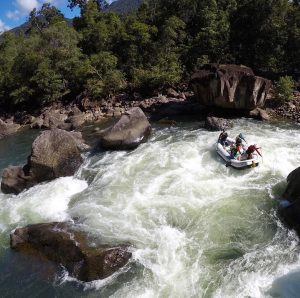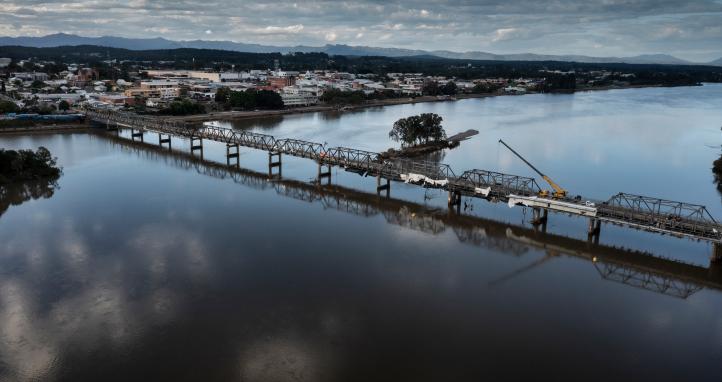The Value of Adventurous Training
Within the ADF, Adventurous Training (AT) faces a fierce battle to become a command priority in a high tempo environment with finite time and resources. It competes with physical activity but has a reputation or misconception more aligned to recreation. However, that reputation is changing as AT learning outcomes are being explored, defined and more widely disseminated. Extant evaluations and research identify significant benefits from AT in terms of retention, morale and mental resilience.[i] AT is also currently being used as a recruitment tool.
The role of AT is to provide an experiential learning medium in a challenging environment to set the conditions for enduring learning and development. It is differentiated from physical and recreational endeavours because it creates an environment that brings to the fore observable behaviours under adverse conditions, thereby providing the opportunity to facilitate meaningful experiential reflection. AT provides an effective medium to expose individuals to complex environments before encountering operational service and combat. [ii] It does so by categorising activities (Table 1 below) into a learning matrix providing guidance on target audience and specified learning outcomes. Of note is that only categories B-D are classified as AT with their respective time frames being linked to achieving real and lasting change.

Table 1: Categories of adventurous training learning outcomes [iii]
The AT learning matrix maps outcomes to individual, small-team or unit requirements, which enables effective integration across the spectrum of service. This is because it explicitly defines objectives tailored to both the needs of participants as well as individual or organisational learning requirements.
Adventurous Training Pathways ‘Prehab’
In the preventative space (also called ‘left of bang’ or ‘prehab’), the ADF prepares its leaders and personnel to thrive in difficult conditions. AT provides an effective medium to expose teams (small-team to unit level) to environments that physically, emotionally, intellectually and morally build capacity to mitigate or minimise the impact of significant adverse personal events. Working collaboratively with military psychologists and SMEs; Unit Adventure Training Leaders (UATL) and Adventure Training Leader Instructors (ATLI) are able to provide sophisticated coaching, mentoring and facilitation skills to achieve the requisite learning outcomes in order to enhance operational capability.
A proactive model of AT supports its integration into units. This model is founded on proposed regional AT cells located with brigades to provide input into AT activities. Such an approach centralises AT knowledge and experience to achieve tailored and collaborative outcomes for individuals and teams.
Recovery & Reintegration
AT can also play a critical role in the aftercare of wounded Service personnel. Adventurous activities of this nature have therapeutic intent and are referred to as Nature-Based Therapy (NBT), Nature Adventure Rehabilitation (NAR), adventure therapy or outdoor development. A body of literature exists that outline the benefit of these activities, with the field increasingly examining the outcomes of outdoor and adventurous activity for veterans. [iv] Specifically, AT and sport can play a role in the aftercare of wounded personnel through aiding in their rehabilitation and enabling them to return to an active life.
A literature review found NBT/NAR to have a positive impact on PTSD symptoms, quality of life and hope, and is beneficial in the process of veterans returning to the workforce. None of the studies reviewed found any negative impact of participation. [v] Additional research, undertaken as a randomized control trial on a one year program, identified that adventurous therapies are a ‘promising supplemental intervention’ for chronic combat-related PTSD which seem to work though a process of 'behavioural activation, desensitization, gradual exposure to anxiety evoking situations and a control over symptomatology’.[vi] Of note however, is that variations are evident in activity outcomes which may be linked back to the nature setting, the length and frequency of the session and the health outcomes measured.

The AUS trial of Exercise BATTLEBACK
On the initiative of Adventurous Training Wing (ATW) and Soldier On, a Working Group (WG) was held over the period 11-12 May 2017 to examine the feasibility of incorporating AT into the recovery and reintegration of serving and ex-serving personnel. The WG was underpinned by a scoping brief that outlined the equifinality of recovery and reintegration, the benefits of synchronising efforts in this space, and the use of AT as a tool to support 'reintroducing individual and group coping strategies and setting the pathway for a commitment to future direction.’[vii]
The key outcome of the WG was ATW and Solider On agreeing to collaborate and conduct a 10-day multi-disciplinary AT expedition for personnel in a recovery and reintegration phase of service. Titled Exercise BATTLEBACK (EX BB), the expedition draws from a UK Ministry of Defence-led programme of the same name. With an abundance of physical and rehabilitation adventure activities available, the value of EX BB lies in its specified participant and organisational outcomes, and adoption of a robust evaluation framework to examine the wider application of AT in recovery and reintegration.
The UK implemented the Battle Back program in 2008 in recognition of the role that AT and adaptive sports play in enabling wounded service personnel to make a physical, psychological and social recovery. Battle Back activities are tailored to the needs of participants and are designed with therapeutic outcomes as an adjunct to existing therapies. Battle Back has also achieved psychosocial outcomes which have enabled participants to move forward with their lives as a result of ‘new horizons of possibility’[viii]
As outlined in the COMD FORCOMD Directive 210/15 FORCOMD Resilience Plan, there is potential for EX BB to achieve outcomes in physical, cognitive, character, psychological and social resilience domains (Figure 1). There are also behavioural benefits that can be explored.

Figure 1. Mapped Exercise BATTLEBACK outcomes.[ix]
This is supported by the Defence Learning Manual, which states that the purpose of AT is ‘to enhance Defence’s operational performance,’ through developing leadership, teamwork, trust, physical and mental fortitude, courage, initiative, resilience, resourcefulness, self-discipline, risk management and stress management. EX BB is consistent with the purpose of AT both in terms of the mapped outcomes and its intent to generate an operational effect by supporting participants on their path to recovery and return to duty.
The flow-on effects of EX BB for ATW will be increased instructor experience and skills in supporting personnel undergoing recovery. Organisational outcomes of the trial include developing and broadening the AT capability, contributing to an evidence-base on AT outcomes, and building partnerships within and external to Defence, in order to synchronise efforts in the recovery and reintegration of wounded, injured and ill personnel.
EX BB will be framed by a robust evaluation framework, incorporating the specified individual and organisational outcomes. The knowledge gained by this will be invaluable for Ex-Service organisations working in the adventure therapy space. It is anticipated that initial results from EX BB will be delivered at DEF Aus 2017.
The value of building partnerships and establishing networks
A number of partnership opportunities exist that will enable ongoing collaboration in the recovery and reintegration of service personnel, while also having the potential to provide greater and more varied AT experiences. Partnerships allow for the sharing of resources and help to reduce 'duplication of effort'.
Microadventures
One key partnership opportunity is between Soldier On and the Army Alpine Association (AAA), especially in Canberra, to integrate microadventures into Soldier On’s regular schedule of activities. Introduced into physical activity nomenclature by Alastair Humphreys, microadventures are activities that are ‘short, simple, local, cheap – yet challenging, refreshing and rewarding.’ Activities of this nature can achieve technical training outcomes and knowledge exchange, which can lay the foundations for longer and more difficult AT challenges. They can also include family involvement at completion through a social function to share and reflect on outcomes and achievements.
This proposed partnership between Solider On and AAA will enable the transfer of considerable AT experience into the ex-serving community, in-turn laying the foundations for a community of like-minded people that can be accessed, both in terms of conducting AT activities and reaching out when in need.
Adventurous Activity Qualifications
Personnel in the AT community have considerable expertise that should be captured to assist transiting ADF members gain civilian employment in physical activity, tourism and outdoor areas. This includes identifying knowledge, skills and training that can translate into civilian qualifications. Working with organisations such as Australian Canoeing enhances the ability of AT personnel to provide up-to-date advice on employment options and will help to develop and grow professional relationships with activity based industries.
Inspiration and aspiration
More broadly than the Army AT community is a plethora of serving and ex-serving individuals who have achieved significant benefit from adventurous activities and can provide inspiration and aspiration to personnel throughout their service. This would see people currently outside the AT space discuss their experiences in areas of leadership, adversity and resilience. The 'Cove' team are trialling the use of a ‘webinar’ facility for up to 100 people and it is anticipated that personnel will be able to share their AT experiences widely through this medium.
Conclusion
The AT Community and AT are critical enablers for the Army and wider ADF to enhance human performance through resilience and leadership development of its personnel. There is great potential in AT being introduced throughout the spectrum of service, specifically in terms of recovery and reintegration. On the initiative of ATW, EX BB will be trialled in November 2017. A grassroots and collaborative initiative, the activity is grounded by research and will provide an invaluable foundation for similar activities to be conducted in the future.
About the authors:
Dan Fussell (RAA) is currently OC Adventurous Training Wing. He came to appreciate the role of AT in developing stress coping mechanisms and resilience after operational service.
Kevin Vowles is an Australian Regular Army Psychologist, a qualified UATL, and a retired professional athlete. He has deployed several times on war-like and non-war-like operations and is currently studying a Masters of Clinical Psychology. His Masters level research project is examining the pre-trauma physiological predictors of future Post-Traumatic Stress Disorder (PTSD).
Emily Chapman Emily Chapman is a RAAF Reservist Operations Officer posted to the Air Liaison Organisation. She is concurrently a PhD candidate researching civil-military interaction in disaster operations at UNSW Canberra. She has a Masters in Evaluation, and her research interests include Defence learning processes, practices and mechanisms.




